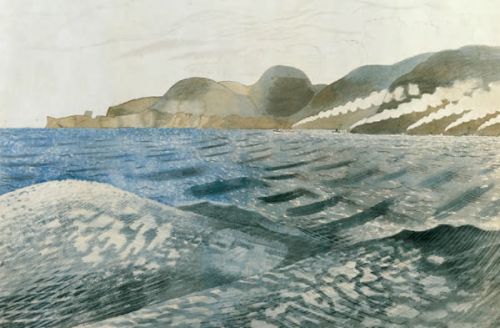
Study for ‘Leaving Scapa Flow’ (recto); ‘The Firth of Forth’ (verso), circa 1940–41
Framed (ref: 2594)
Signed
Watercolour over pencil
171/4 x 23 in. (43.7 x 58.5 cm)
Tags: Eric Ravilious pencil watercolour seascapes and skyscapes war

Signed
Watercolour over pencil
171/4 x 23 in. (43.7 x 58.5 cm)
Tags: Eric Ravilious pencil watercolour seascapes and skyscapes war
Provenance: Artist’s family until 2005; private collection.
Exhibited: Eastbourne Towner Art Gallery, extended loan; The Twentieth Century,
The Fine Art Society, London, October 2005 (cat. no. 24).
Literature:Anne Ullmann (ed.), Ravilious atWar,The Fleece Press, Upper Denby, Huddersfield, 2002, illus. p. 101, no. 50. WW2 - War Pictures by British Artists, Edited by Sacha Llewellyn & Paul Liss, July 2016, FIG. 2, page 46.
During WW2 Ravilious was employed as a Ministry of Information artist specialising in Admiralty topics
Scapa
Flow is a body of water in the Orkney Islands, Scotland, and was the
site of Britain’s chief naval base during the SecondWorldWar . Churchill
ordered the construction of a series of causeways to block the eastern
approaches after Scapa Flow was penetrated by German submarine U-47 in
October 1939.
Ravilious
refers to Leaving Scapa Flow in a letter to E.M.O’R. Dickey on 20 June
1940, as one of a series of watercolours intended for exhibition,
probably for a war-effort show at the National Gallery, London,
organised by the Artists’Advisory Committee (see Anne Ullmann [ed.],
Ravilious atWar, Upper Denby 2002, p. 99).The finished watercolour is in
the collection of Cartwright Hall, Bradford.
In July 1941, again
attached to the Admiralty as an OfficialWar Artist, Ravilious painted
on the Isle of May, in Scotland, near the Firth of Forth.Weekly east
coast convoys formed there to make their hazardous voyages down to
Sheerness in Kent.The Forth Bridge here is shown protected by Barrage
Balloons. Ravilious was killed on 2 September 1942, accompanying a Royal
Air Force air–sea rescue mission off Iceland.
On reverse;
